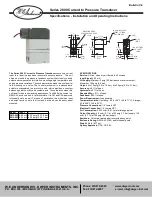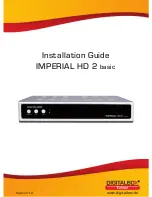
QST
®
– Devoted entirely to Amateur Radio www.arrl.org
Reprinted from December 2013
QST
45
Spurious response: Not specified.
IF rejection: RX A, 146 MHz, 102 dB,
440 MHz, >135 dB; RX B, 146 MHz,
101 dB, 440 MHz, >135 dB.
Image rejection, RX A, 146 MHz, >135 dB,
440 MHz, 82 dB; RX B, 146 MHz,
>135 dB, 440 MHz, 98 dB.
Squelch sensitivity: < 0.178 µV.
At threshold, 146 MHz, 0.3 µV (min),
1.17 µV (max), 0.1 µV (auto);
440 MHz, 0.26 µV (min), 1.05 µV (max),
0.1 µV (auto).
Audio output: at 10% THD, >200 mW into 8
W
218 mW at 10% THD into 8
W
;
load (external speaker); >400 mW into
THD at 1 Vrms,1.4%.
16
W
load (internal speaker).
Transmitter
Transmitter Dynamic Testing
Power output: 5.0 W (high), 2.5 W (medium),
146 & 440 MHz, 4.7 W (high), 2.2 W (med),
1.0 W (low2), 0.5 W (low1), 0.1 W (s-low).
0.9 W (low2), 0.4 W (low); 0.07 W (s-low,
146 MHz), 0.130 W (s-low, 440 MHz)
at full charge and 13.8 V dc external power.
Spurious signal and harmonic suppression:
>70 dB; meets FCC requirements.
>60 dB (high, med), –13 dBm (low, s-low).
Transmit-receive turnaround time (PTT release
Squelch on, S9 signal, 146 MHz, 124 ms,
to 50% of full audio output): Not specified.
440 MHz, 126 ms.
Receive-transmit turnaround time (“tx delay”):
146 MHz, 52 ms, 440 MHz, 64 ms.
Not specified.
Size (height, width, depth): 4.9 × 2.3 × 1.0 inches (with protrusions); antenna length: 7.0 inches.
Weight: 9.0 ounces (with battery and antenna).
Price: ID-51A, $580; OPC-2218LU USB cable, $70.
†
BP-271 7.4 V, 1150 mAh Li-ion battery and BC-167 wall charger supplied.
Available options: extra BP-271 battery, $90; BP-272 7.4 V, 1880 mAh Li-ion battery,
$125; BC-202 drop-in charger, $60; BP-273 battery case for 3 AA cells, $60; CP-12L
cigarette lighter dc power cable with filter, $40.
*Power consumption in DV mode: receive equal to FM; transmit,
≤
25 mA greater than FM.
**Both Receiver A and Receiver B had equal performance, except when noted. DV not tested;
PN9/GMSK signal generator was not available.
See the Digital
Edition of
QST
for a video
overview of the
Icom ID-51A.
see what is happening. I liked this feature a
lot. Hold down the
QUICK/SPCH
button for a
second, and the voice tells you your operating
parameters on the fly.
A Home CH (home channel) Beep function
works well: you can program your favorite
(your home repeater, for example) frequency
as the Home CH and whenever your VFO
dial, or DR, or memory channel selection hits
the Home CH, a beep is emitted, letting the
user know his/her home repeater has been se-
lected. Again, the idea here is to free the eyes
from having to look at the display, and again,
that is a safety feature while driving.
Summary
The reader will note that this review is a few
pages long, with lab results and graphics.
The ID-51A comes with two manuals as I’ve
already noted, for a total of more than 400
pages. Hence, there is no way to cover every
nuance of this radio. I have, in this review,
attempted to hit the hot buttons for this radio.
The menu choices for many of the functions,
including the BC radio function, for example,
are extensive and frankly, astounding. The
programmers at Icom seemed to have left little
to be desired in a radio like this. It is incred-
ible, and that is no hyperbole.
The purchaser of this radio, like other
D-STAR radios, will benefit from a good un-
derstanding of the D-STAR system network,
and especially of the four main programmable
parameters that are at the heart of the system.
And in that subset, the UR call field, with its
myriad commands and modes, is the most
critical to understanding and enjoying the sys-
tem. So, especially if you are new to D-STAR,
while you are waiting for your package to ar-
rive, get a good source of information (there is
a plethora on the Internet) and bone up on it so
you’ll be able to enjoy this radio out of the box.
Roland Kraatz, W9HPX, adds: “The impor-
tance of the UR call field to the successful use
of D-STAR’s functionality cannot be over-
emphasized. A lot of new users have difficulty
setting up the DR mode so that their transmis-
sion passes through the repeater’s gateway to
the Internet. In that regard, the website
www.
dstarinfo.com/Data/Sites/1/GalleryImages/
FullSizeImages/id-51-beginner.pdf
has a lot
of how-to info for the ID-31 D-STAR radio
that is almost exactly applicable to the ID-51,
particularly the ‘Easy Repeater Operation’
section. The other ID-31 sections are also use-
ful for the beginning user.”
For me, the ultimate litmus test for a review
radio is whether or not I would actually buy
one for myself. In this case, the answer is
yes, even though the radio is not inexpensive
compared to a standard dual band handheld. I
loved this radio and opening the package and
discovering all of its features and functions.
Manufacturer
: Icom America, 2380 116th Ave
NE, Bellevue, WA 98004;
www.icomamerica.
com
.























